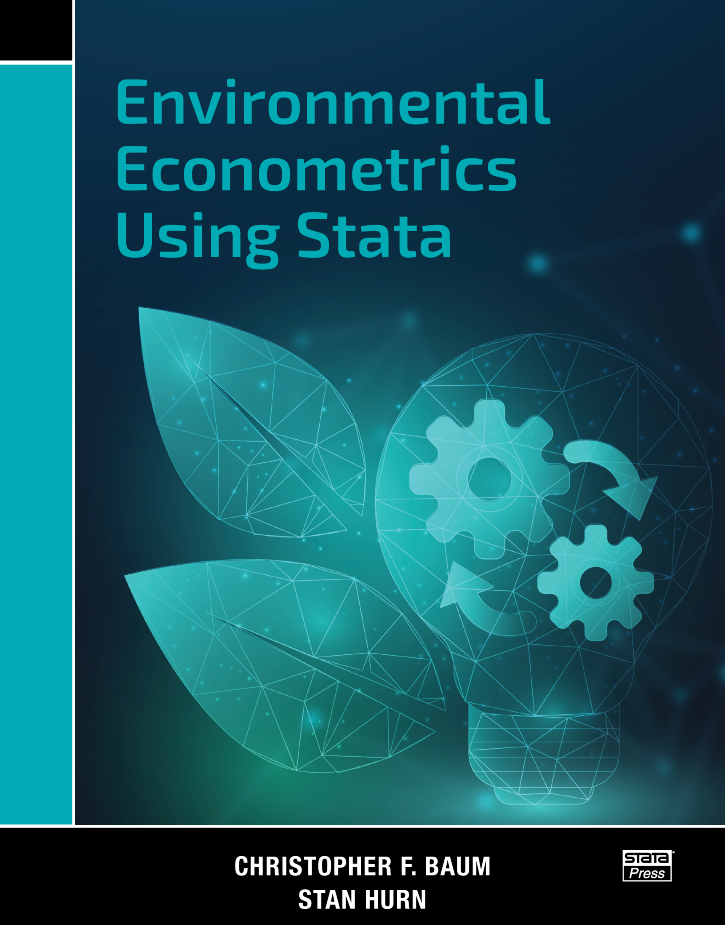Environmental Econometrics Using Stata is written for applied researchers that want to understand the basic theory of modern statistical methods and how to use them. It is also perfectly suited for teaching. Each chapter is motivated with real data and ends with a set of exercises. The book is also inherently interdisciplinary. The questions posed by environmental issues are relevant to researchers in the physical sciences, economics, sociology, political science, and public health, among other fields.
Each chapter begins with a real dataset and research question. The authors then provide a gentle introduction to the statistical method and demonstrate how to use it to answer the research question. The authors discuss the assumptions about the data and the model, demonstrate the Stata commands used to fit the model and check the model assumptions, and interpret the results. The workflow of the book mimics the workflow that would be required to present your results to an academic audience.
The book is of interest not only for its exposition of the topics but also for its breadth. The book presents estimators for continuous, binary, and ordered outcomes in cross-sectional data; univariate and multivariate time series with stationary and nonstationary data; linear and dynamic panel data; and spatial models and fractional integration. The range of methods is not arbitrary; it is a function of the questions posed by environmental data and reflects the challenges faced by researchers from different disciplines to answer a wide range of questions using modern statistical methods.
Time-carying volatility
Air pollution in Santiago, Chile
Linear regression and OLS estimation
Interpreting and assessing the regression model
Serial independnece
Normality
Estimating standard errors
3. BEYOND ORDINARY LEAST SQUARES
Properties of estimators
Asymptotic normality
Asymptotic efficiency
Maximum likelihood and the linear model
Hypothesis testing
Wald test
LM test
Method-of-moments estimators and the linear model
Testing for exogeneity
4. INTRODUCING DYNAMICS
Specifying and fitting dynamic time-series models
5. MULTIVARIATE TIME-SERIES MODELS
The VARMA model
The VAR model
Analyzing the dynamics of a VAR
Impulse-responses
Orthogonalized impulses
Long-run restrictions
Unit roots
First-generation unit-root tests
Fitting VECMs
System estimation
Testing for cointegration
Cointegration and structural breaks
Forecast evaluation
Daily forecasts of wind speed for Santiago
Forecasting with logarithmic dependent variables
Generalized linear models
The Kalman filter
Vector autoregressive moving-average models in state-space form
Unobserved component time-series models
Testing
Bilinear time-series models
Threshold autoregressive models
Smooth transition models
Markov switching models
The generalized autoregressive conditional heteroskedasticity model
Alternative distributional assumptions
Asymmetries
Motivating multivariate volatility models
Multivariate volatility models
Spatial models
Spatial error model
Fitting spatial models by maximum likelihood
Spatial error model
Estimating spillover effects
Model selection
Ordered dependent variables
Censored dependent variables
Autocorrelations and long memory
Testing for long memory
Estimating d in the frequency domain
Maximum likelihood estimation of the ARFIMA model
Fractional cointegration
The varlist
The numlist
The if exp and in range qualifiers
Local macros
Global macros
Scalars
Matrices
Looping
The generate command
The egen command
Computation for by-groups


